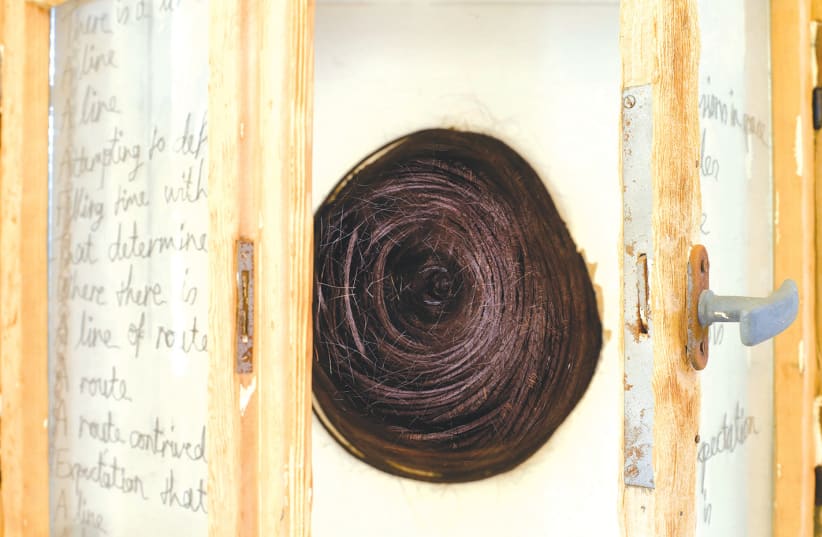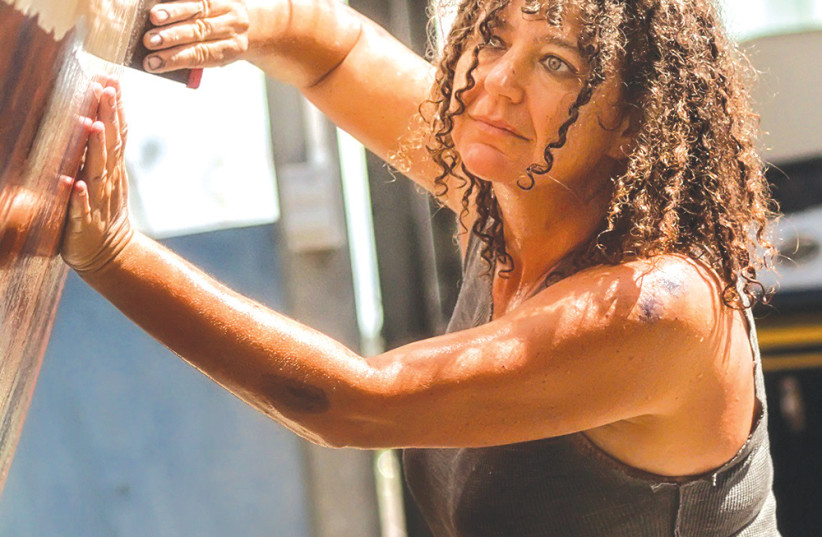Linda Hufnagel has an eye for detail, lots of it. Her Ocean collection, currently on display at the Negev Museum of Art, is an aesthetic dynamo that simply purrs, if not roars, from item to item. The show moniker suggests a sense of vastness but also implies immense strength lurking just beneath the surface.
The Australian-born artist has the requisite credentials for the offering which occupies both floors of the museum building. For starters, she racked up many an hour at sea, sailing 25,000 nautical miles around the world with her husband Evgeny.
That sounds likes quite a daunting rite of passage, especially considering she had zero seafaring experience before the couple stepped onto the catamaran they swapped for the jeep they had used to navigate their long and winding way through the back roads, and deserts, of Africa.
Surprisingly, Hufnagel insists the name of the exhibition, curated by Nirit Dahan, does not reference her time at sea. She explains that, in fact, the show is an amalgam of several projects. “There are four exhibitions – The Raft, Lacuna, There Is A Line, and The Horse Is Dead,” she notes. All of which makes for an expansive and rich viewing experience at the museum.
But Ocean also incorporates contrasts, complementary elements and concepts that – possibly similar to a sea vessel maintaining its balance across choppy waters – coexist in an oxymoronic state of affairs.
Take, for example, the second of the aforementioned exhibition titles. “The word lacuna means an empty space, a hollow,” says Hufnagel. There is a sonic context in there too. “It is also the pause in music. The silence in between is also lacuna. It’s a pause, an emptiness, it’s an empty space.”
Then again, as we know, Mother Nature doesn’t allow for voids. I point that out to the artist. “That’s what the exhibition is about,” Hufnagel comes back at me. “I even wrote that space is only empty when you want it filled.”
That is a fascinating notion which takes a while to ingest and digest. Is it really all about the subjective? Is there no such thing as an objective, absolute, fact on the ground?
When it comes to literary expression, artists who convey their thoughts and emotions through their tactile creations often fall short on the verbal front. Not so with Hufnagel, not by a long shot.
There are numerous handwritten texts in the museum array, many of which are patently designed to leave the viewer chewing some cerebral cud. The contextual theme resonates across the Lacuna section. One fetching boat-shaped ink drawing is augmented by the scripted thought-provoking idea that: “A hole near a boat won’t cause it to sink, but a hole in the boat will. So is the hole to blame?”
That yin-yang ethos also appears in the large Lacuna I work, which consists of threads dipped in wax, as well as some wood, rusted wire and felt components. Here too, it is very much a matter of what you can’t see that completes the conceptual picture. “That’s why the Lacuna exhibition was in the form of boats,” Hufnagel expounds. “I wanted it to be about looking at the space the boat holds rather than the actual form.”
Evidently, there is more to the exhibits, and Hufnagel’s artistic and life philosophy, than meets the eye. “I chose the boat because I’m always concerned with movement and transitions.” I wondered – logically - whether the name of the current exhibition was designed to impart a sense of plying one’s way through great bodies of water. Perhaps suggesting some sort of voyage we, the general public, may embark upon as we traverse the exhibition spaces?
That, it seems, was not at all in the creative game plan. “Let’s be clear about one thing,” Hufnagel puts me right in no uncertain manner. “The title of the exhibition is confusing because I talk about my sailing. I didn’t want people to take it too literally. It was never about an ocean. The sailing that I did was four years after I’d finished all the work.”
Fair enough, but there are numerous references to the sea at the museum. Perhaps that was lurking somewhere in Hufnagel’s psyche.
She was also keen to head any thoughts of regurgitation off at the pass. “It’s four different exhibitions that I’ve connected in a new concept. In myself it was nice to connect it in a different way. It is a new exhibition in that sense. It’s not a retrospective.”
HUFNAGEL comes across as a strong-willed character who always goes the whole hog. Many of the works on view in Beersheba look labor-intensive in the extreme. The aforementioned Lacuna I, and Raft III – a generously dimensioned work comprising hundreds of rusted wire cubes overlain with acrylic paint – indicate the lengths to which she is prepared to go to translate her muse into tactile corporeal form.
There is also something palpably down-to-earth about the artist, which also comes across in the raw materials she employs. “This is woven from cotton, cotton that I’ve put through wax, thousands of meters of cotton through wax,” she proffers as we get up close to Lacuna I.
“It’s woven and then I create the three-dimensional shape. So it actually goes from two-dimensional to three-dimensional. This is felt, and there’s rusted wire. You can see I’m attracted to the same mediums. They’re all mediums of no value. They are all organic and natural.”
The There Is A Line throwback spread is made of hundreds of inventory and filing cards – talk about a blast from the pre-PC past! – with primordial humanoid ink shapes and stickers, and some 3D elements with threads inserted seemingly haphazardly.
But nothing on Hufnagel’s labor-intensive chart beats The Ocean, from the Lacuna series. The 3m. by 2.7m. creation incorporates thousands of snippets with words and letters painstakingly cut out from typewritten sheets of paper.
For those under the age of 40, before the age of the personal computer, people used mechanical typewriters with a raised stepped keyboard that, when a key was pressed – none too gently – it pushed a long metal arm up to the paper where it left an impression of the relevant letter, after hitting an inked ribbon en route. The woman is clearly willing to put in a shift or two to get her artistic job done and out there.
There is so much to see, feel, ponder and wonder at across the textures, shapes, layers and energy flows that meet you in The Ocean. Consider the words Hufnagel displays on one of the window panes of The Tunnel: “There is a line. A line. A line. Attempting to define. Filling time with. That determine. Where there is. A line of routes. A route. A route contrived. Expectation that. A line. A line.”
Enough said?
Ocean closes on December 4.
For more information: https://negev-museum.org.il/

